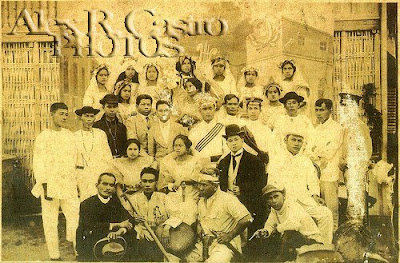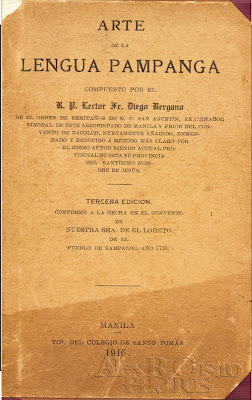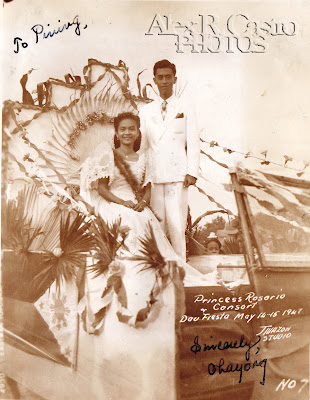 DRAMA KING. Mabalacat zarzuela actors and actresses in a Kapampangan production of Rizal's "Noli Me Tangere". My grandfather, Gerardo Razon Castro, wearing a derby hat, was cast in a leading role as Crisostomo Ibarra with A. Malig as his love interest, Maria Clara. Circa 1915. From the photo collection of Mr. Daniel Henson Dizon, Angeles City.
DRAMA KING. Mabalacat zarzuela actors and actresses in a Kapampangan production of Rizal's "Noli Me Tangere". My grandfather, Gerardo Razon Castro, wearing a derby hat, was cast in a leading role as Crisostomo Ibarra with A. Malig as his love interest, Maria Clara. Circa 1915. From the photo collection of Mr. Daniel Henson Dizon, Angeles City.We are a family of nervous wrecks, and we shun being in the limelight even for just 5 seconds. Performing in public was never our strong point. At reunions, our family would recede in the background when it was time for those mandatory clan presentations. My Dad would never be caught dead with a microphone, unless he is pumped up with whiskey. In my elementary school days, when I was chosen to recite a poem on the occasion of United Nations’ Day, my knees shook so badly, I flubbed my lines and left the stage with bowed head. Only Big Sis took to the spotlight, winning singing contests in high school--only because she was such a popular campus figure and could get away warbling a song like Vilma Santos.
So it came as a total surprise when I learned from my Auntie Elsie, that my grandfather—Gerado Razon Castro (b. 3 Oct. 1894/d.30 Dec. 1968) or Ingkung Dando—was a stage actor. “He had such a good speaking voice”, my aunt remembered, “and he could recite Kapampangan verses with facility and conviction. He had stage presence! And it’s said in his younger days, he bagged the role of Rizal in a zarzuela…”.
Of course, coming from his No. 1 fan, I took her rave reviews with a grain of salt. I was old enough to remember Ingkung, and certainly, he did not have the classic matinee look required of a performer. Fair complexioned, he was short, had chinky eyes, but I do know he had great sartorial style, cutting a mean figure in his white pants, straw hat and baston whenever he went to Church. I thought my father—his son—was the looker in the family.
Also, I never heard Ingkung recite a poem or sing a song. I doubt if he could carry a tune, although he would entertain us by putting us on his knee and sing..”Kikinaking..kikinaking..”. Oh yes, he’s a good whistler too, which he would often do to summon the breeze, when the day was hot and sweltering. But performing as a lead star in a zarzuela? Unthinkable!
Until a casual visit to the home of local historian Daniel Henson Dizon, a relative, yielded a picture that had me jumping up and down. It was a circa 1915 group picture of a zarzuela repertory in Mabalacat. I instantly recognized Ingkung as he was right smack in the middle of the photo, with a derby hat. He looked exactly like the old portrait we have of him, now lost, that used to hang in our living room.
Tatang Dan quickly filled me in on what he knew about the zarzuela photo from his personal collection. It was a Kapampangan zarzuela, based on the novel of our national hero, Noli Me Tangere, that was mounted by the people in the picture—all Mabalacat residents. The lead performers were Gerardo Castro as Crisostomo Ibarra, A. Malig as Maria Clara and Mariano de la Cruz as Pilosofo Tacio. As there were no local theaters then, the play was staged on platforms constructed near the San Felipe Bridge. The play was directed by J. L. Mendoza.
Could this zarzuela have been based on Juan Elias de Guzman’s translated opus? De Guzman, a Mabalacat resident, is acknowledged as the first known writer in Spanish and Pampango. He translated Jose Rizal's Noli Me Tangere in Kapampangan after the hero's death. When Juan Elias died, it was said that Rizal's portrait fell from the wall at the precise moment of his death . He was the first to be interred in the Municipal Cemetery of Mabalacat, constructed in 1907.
But back to the zarzuela photo. Another surprise awaited me. On the back of the photo were written the individual names of the performers and the roles that they essayed, a chosen list that included : J.L. Mendoza (Director General), S. de la Cruz (Director del Drama), M. de la Cruz (Pilosofo Tacio y Director de Ecsena),Gerardo Razon Castro (Crisostomo Ibarra), A. Malig (Maria Clara), Emilio Dominguez (Padre Salvi), A. de la Cruz (Elias), A. Mendoza (Capitan Pablo), A. Dominguez (Teniente Guevarra), Laureano Angeles (Maestro de Escuela), B. Castro (Padre Damaso), S. Castro (Capitan Tiago), L. Castro (Capitan General), Montoya (Sacristan Mayor), Francisco Siopongco (Alcalde), N. Castro (Padre Dominico), Dizon (El Tulisan), A. de la Cruz (Asistente General), F. Sablay (Directora de Musica)
A zarzuela star at age 21—that’s my Ingkung! I wonder, did he belt a song like a Broadway star? Did ladies swoon whenever he entered the stage? Was he given acting awards? What did critics say of his thespic skills, was the show praised or panned? With so many Castros in the cast, could they have been relatives? Is acting really in the blood?
I would probably never find out, but with thoughts of Ingkung Dando as the ultimate zarzuela idol to warm me, I am now ready to put my stage fright behind--and break a leg!
(*NOTE: Feature titles with asterisks represent other writings of the author that appeared in other publications and are not included in the original book, "Views from the Pampang & Other Scenes")










